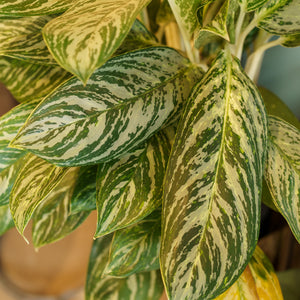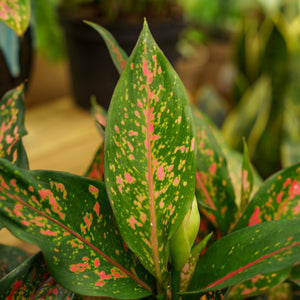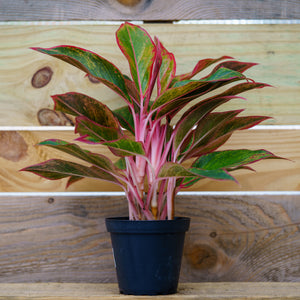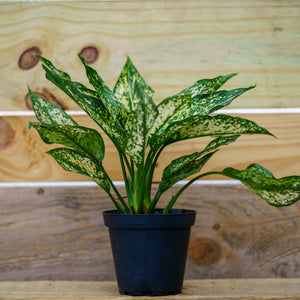The Aglaonema Guide
Aglaonema, commonly known as Chinese Evergreen, is a genus of flowering plants native to the tropical and subtropical regions of Asia and New Guinea. They are highly valued for their lush, attractive foliage, which comes in a variety of colors and patterns, ranging from deep greens to silvers and reds. Aglaonema plants are known for their adaptability and ease of care, making them popular choices for both homes and offices. These versatile plants can thrive in low-light conditions and require minimal maintenance. Here's what you need to know about planting and caring for Aglaonema:
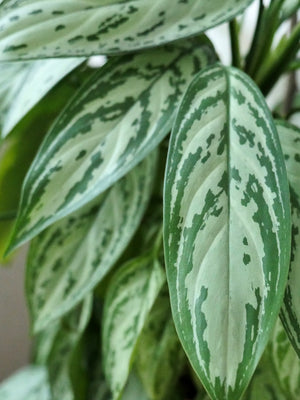
About
Aglaonema, commonly referred to as Chinese Evergreen, belongs to the Araceae family and stands out as a captivating genus of perennial, evergreen plants admired for their striking foliage and resilience. With over 20 recognized species, Aglaonema plants are native to the tropical and subtropical regions of Asia and New Guinea, enriching indoor and outdoor spaces with their vibrant presence.
These plants are celebrated for their broad, lance-shaped leaves, which display an array of colors and patterns, from deep greens and silvers to rich reds and pinks. The variegated leaves often feature intricate patterns, creating a visual spectacle that enhances the aesthetic appeal of any environment. Aglaonema's ability to thrive in low-light conditions and tolerate a range of humidity levels makes them an excellent choice for both novice and experienced gardeners.
One of the standout features of Aglaonema is their low maintenance and adaptability. They can flourish in a variety of soil types, although they prefer well-drained, peat-based soil. These plants are also known for their air-purifying qualities, making them a popular choice for improving indoor air quality in homes and offices.
Aglaonema plants typically grow at a moderate pace, reaching heights of one to three feet, making them suitable for tabletops, floor placements, and even as accent plants in larger mixed arrangements. While primarily grown for their foliage, they may occasionally produce small, inconspicuous flowers that add a subtle charm to their overall appearance.
In terms of care, Aglaonema plants require minimal effort. They thrive in low to medium light but can tolerate low light conditions, making them versatile for different indoor settings. Regular watering, allowing the top inch of soil to dry out between waterings, helps maintain their health. Additionally, occasional feeding with a balanced liquid fertilizer during the growing season can promote vibrant growth and foliage.
Popular species within the Aglaonema genus include Aglaonema 'Silver Bay' and Aglaonema 'Red Emerald,' each bringing its unique foliage patterns and colors to the forefront. Whether placed as a striking centerpiece in a room, grouped together to create a lush, green corner, or integrated into a mixed indoor garden, Aglaonema plants offer an element of elegance and tranquility.
By choosing Aglaonema for your indoor space, you not only enhance its visual appeal but also contribute to a healthier living environment. Embrace the diversity and enduring beauty of Aglaonema, and create a space that resonates with nature's vibrant hues and calming presence.
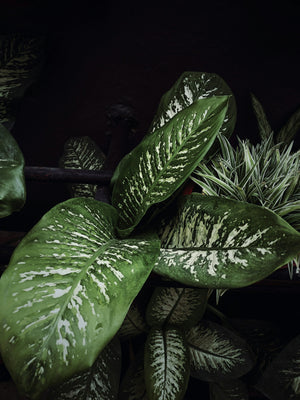
Planting
Planting Aglaonema requires careful consideration to ensure their successful establishment and healthy growth. Here are essential guidelines for planting and caring for Aglaonema:
Soil: Aglaonema plants thrive in well-draining soil rich in organic matter. They prefer a slightly acidic to neutral soil with a pH between 5.5 and 6.5. To create an optimal planting environment, prepare the site by loosening the soil and incorporating generous amounts of compost or peat moss. This enhances drainage, fosters fertility, and provides a nutrient-rich foundation for Aglaonema.
Sunlight: Aglaonema plants prefer bright, indirect light but are highly adaptable to low-light conditions. When selecting a planting location, prioritize areas that receive filtered light or partial shade. Direct sunlight can scorch the leaves, so avoid placing them in locations with intense afternoon sun.
Watering: Adequate and consistent watering is crucial, especially during the initial stages of Aglaonema establishment. Water the plant thoroughly immediately after planting and continue with regular irrigation. Adjust the watering frequency to keep the soil evenly moist but not waterlogged. Allow the top inch of soil to dry out between waterings to prevent overwatering, which can lead to root rot.
Mulching: Applying a layer of organic mulch around the base of Aglaonema offers multiple benefits. Mulch helps conserve soil moisture, suppresses weed growth, and regulates soil temperature. Utilize materials such as wood chips, bark, or compost as mulch. Maintain a gap of a few inches between the mulch and the plant's base to prevent excess moisture accumulation and potential rot.
Pruning: Aglaonema typically requires minimal pruning to maintain a strong and balanced structure. Focus on removing any yellowing or damaged leaves. The ideal time for pruning is during the growing season, from spring to early fall. Regularly wiping the leaves with a damp cloth can also help keep them dust-free and enhance their appearance.
By adhering to these fundamental planting and care guidelines, you can facilitate the successful establishment and robust growth of your Aglaonema plants. These practices will contribute to the longevity and beauty of your indoor or outdoor space, allowing the Aglaonema to thrive and grace your environment for years to come.

Care
Aglaonema, with their striking and resilient foliage, require specific care practices to ensure their optimal growth and vitality. Here are comprehensive guidelines for the care of Aglaonema, ensuring they grace your indoor or outdoor space with enduring beauty:
Watering: During the growing season, offer moderate and consistent watering to your Aglaonema. Aim to keep the soil evenly moist, but not waterlogged. Water thoroughly when the top inch of soil feels dry to the touch. Avoid letting the plant sit in standing water, as this can lead to root rot. In periods of low humidity or elevated temperatures, additional misting or a humidity tray may be necessary to maintain adequate moisture levels around the plant.
Pruning: Aglaonema generally requires minimal pruning, but selective care enhances their overall health and aesthetic appeal. Remove any yellowing, dead, or damaged leaves to preserve the plant's vitality and appearance. Shaping can be employed to achieve the desired size and form. Regularly wiping the leaves with a damp cloth helps keep them dust-free and allows for better light absorption.
Fertilizing: Fertilization plays a pivotal role in promoting vibrant growth in Aglaonema. Apply a balanced, water-soluble fertilizer every 4-6 weeks during the growing season (spring and summer). Adhere to the recommended application rates and timing specified by the manufacturer. Exercise caution to avoid over-fertilizing, as it can negatively impact the plant's health. When uncertain, opt for a conservative approach and use less fertilizer to ensure the health and longevity of your Aglaonema.
Soil and Sunlight: Aglaonema thrives in well-drained, peat-based soil and prefers bright, indirect light. While they exhibit tolerance to low-light conditions, providing filtered light or partial shade will enhance their growth and leaf coloration. Avoid direct sunlight, which can scorch the leaves. Mulching around the base of the plant helps retain moisture and regulates soil temperature, creating a conducive environment for healthy growth.
Pests and Diseases: Though generally resilient, Aglaonema can face challenges from pests like spider mites, mealybugs, and aphids. Vigilance is key—monitor your plants for signs of infestation or disease. Swift action with appropriate insecticidal soap or neem oil, when necessary, will help safeguard the health and vitality of your Aglaonema. Ensuring proper air circulation and avoiding overwatering can also prevent common fungal issues.
By adhering to these holistic care guidelines, your Aglaonema will flourish, becoming a perennial source of beauty and tranquility in your indoor or outdoor space for many years to come.
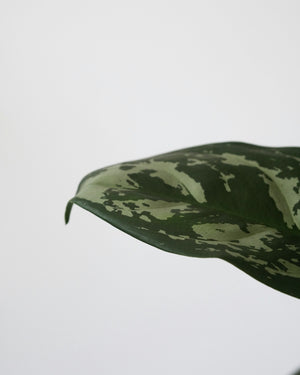
How To Use
Aglaonema, with its stunning foliage and adaptable nature, offers a wealth of possibilities to enhance your indoor and outdoor spaces. Tailor its characteristics to your advantage with these insightful recommendations:
Showcase of Elegance: Make a statement by featuring Aglaonema as a striking focal point in your home or garden. Place a cluster of these charming plants in a prominent area to exhibit their vibrant leaves and attractive patterns. Alternatively, mix and match different Aglaonema varieties for a diverse display that evolves beautifully throughout the seasons.
Indoor Greenery: Aglaonema's tolerance for low light makes it an ideal candidate for indoor environments. Use these plants to brighten up dimly lit areas, such as offices, hallways, or living rooms. Their air-purifying qualities will also contribute to a healthier indoor atmosphere, making them perfect for any indoor setting.
Colorful Accents: Turn utilitarian features into eye-catching elements by planting Aglaonema in decorative pots. Their compact and bushy growth makes them ideal for adding a burst of color to tabletops, shelves, or windowsills. Experiment with various container sizes and shapes to customize your indoor or outdoor space.
Container Charm: Explore creative container gardening by cultivating Aglaonema in pots or containers. This allows you to move these delightful plants to different areas, adding bursts of color to patios, decks, or even balconies. Use stylish containers to enhance their visual appeal and create a cohesive look.
Companion Planting: Combine the beauty and functionality of Aglaonema by using them as companion plants. Their vibrant foliage complements a variety of other plants. Integrate Aglaonema into mixed borders or group them with other tropical plants to create visually pleasing and ecologically supportive plant communities.
Office Decor: Aglaonema is perfect for adding a touch of nature to office environments. Place them on desks or in office corners to create a calming and productive workspace. Their low maintenance requirements make them an excellent choice for busy settings.
Whether you're seeking a focal point, an indoor greenery solution, a colorful accent, or a potted masterpiece, Aglaonema brings elegance and versatility to your space. Consider their moderate size, stunning foliage, and adaptability when planning your home or garden decor. With Aglaonema, you're not just decorating; you're crafting a masterpiece that evolves with the seasons, adding a touch of sophistication and tranquility to your surroundings.
Conclusion
Aglaonema, with its lush foliage and adaptable nature, is an exceptional choice for enhancing both indoor and outdoor spaces. These versatile plants offer not only aesthetic appeal but also ease of care, making them ideal for a wide range of environments. By following the planting, care, and usage guidelines provided, you can ensure that your Aglaonema plants thrive and continue to bring beauty and tranquility to your surroundings.
Whether used as a striking focal point, a colorful accent, or a reliable companion plant, Aglaonema's unique characteristics make it a valuable addition to any plant collection. Embrace the elegance and resilience of Aglaonema, and enjoy the vibrant touch of nature it brings to your home, office, or garden.
By selecting and nurturing Aglaonema, you are not only enhancing your space but also contributing to a healthier, more inviting environment. Explore the diverse varieties and creative possibilities that Aglaonema offers, and transform your surroundings into a harmonious haven of natural beauty.

